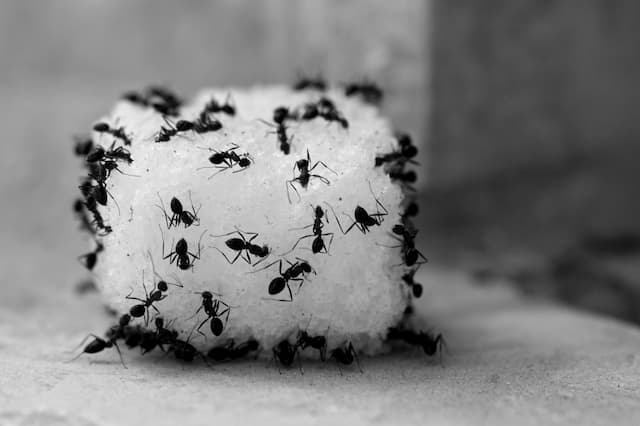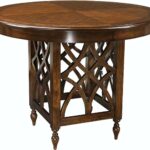There are 12 safe ways to get rid of sugar ants at home and prevent them from entering the house with the help of natural, nontoxic solutions that are easily available and that don’t add chemicals or toxins to the home and environment. Other ant species can also be gotten rid of using these techniques.
Table of Contents
How to Get Rid of Sugar Ants Naturally?
Eliminate Their Food Source and Habitat
Making sure sugar ants have no easy access to food sources can decrease the number of ants that enter the home, increasing the likelihood that home remedies will be effective in completely getting rid of ants and averting an ant problem before it arises. Food containers ought to be completely sealed. Every day or every other day, the house should be cleaned of food crumbs, and garbage should be taken out. Pet bowls should be removed and cleaned as soon as the pet is finished eating because ants are attracted to pet food (including bird food). As they offer ants a good habitat to invade, build nests, and live, eliminating damp spots and rooted wood is also essential.
Combine Glass Cleaner and Liquid Detergent
Spraying glass cleaner with liquid detergent or dish soap can be used to kill sugar ants directly or in areas where they appear to come from or frequently congregate. Spraying may be followed by wiping down the areas, leaving a thin film behind to keep pests out. Some people may prefer to use plain hand soap diluted with water if the scent of glass cleaner is overpowering.
White Vinegar
Sugar ants can be killed and driven away with white vinegar. You can spray vinegar directly onto the ants to kill them or into their holes to dilute vinegar (50:50 vinegar and water). Additionally, you can use diluted vinegar to clean the floors and countertops throughout the house to ward off sugar ants and keep them from coming inside. Even after the vinegar dries and is undetectable to humans, ants can still smell it. Additionally, vinegar works well as a disinfectant and an insect repellent.
Essential Oils
Neem, cinnamon, tea tree, and peppermint are all natural insect repellents. Two cups of water can be diluted with ten to twenty drops of tea tree oil, cinnamon oil, neem oil, peppermint oil, or any other essential oil. This mixture can then be sprayed around the house and allowed to air dry. This has the potential to be effective against mosquitoes and other insects.
Lemon Eucalyptus Oil
The lemon eucalyptus tree yields lemon eucalyptus oil, which functions as a natural insect repellent. To keep sugar ants from entering or leaving the anthill, place a cotton ball saturated with the undiluted oil in areas where they have previously been observed frequently. Every few days, the cotton ball can be changed.
Boiling Water
To quickly and effectively kill ants inside a home, pour boiling hot water into any sugar ant holes you find there. Anthills may seem small, but beneath them are large ant colonies, so a single pour of boiling hot water won’t completely eliminate all of the ants inside.
Boric Acid
Within three weeks of exposure, sugar ants, including their queen, can be killed by a type of poison known as boric acid that erodes their outer shells and stomachs. Boric acid, eight teaspoons of sugar, and one cup of warm water can be combined to create a solution; the ingredients should be stirred until the mixture dissolves. Place cotton balls that have been soaked in this mixture all over the house, particularly in spots where ants are frequently seen. Alternatively, the solution can be poured into ant hills. By combining the powder with something sweet, like maple syrup or corn syrup, which will draw the sugar ants, you can use boric acid to make an ant trap. You can set up this trap in places where ants are active. When handling boric acid, gloves should be worn and it should be kept out of the reach of children and pets.

Bay Leaves
Because they are organic materials with a potent scent, bay leaves can effectively evict pharaoh ants. Put these tiny, fragrant leaves where you’ve seen insects. You could even find the nest and spread the leaves to eliminate the entire colony.
Borax and Sugar Water
Your neighborhood supermarket should carry a powdery substance called borax. White sugar and Borax powder should be combined equally to make a thick paste-like substance. The areas where you’ve seen the ants, apply this mixture. Although it can be extremely hazardous to insects, this will serve as reliable ant bait and food.
Boric Acid Powder
This is a further efficient method of getting rid of ants. Although it is a powerful poison that can get rid of insects, using it if you have kids or pets might not be the best idea. Borax and the acid resemble each other in some ways, but the acid is much safer for kids and animals.
Natural Repellents
In locations where you’ve seen sugar ants, use natural repellents. These include substances like peppermint oil or lemon juice, which have potent aromas that will frighten these insects away. Because sugar ants detest the smell of plastic, you should also try putting Rubbermaid or Tupperware containers throughout your house.
Call a Professional!
Although there are many DIY options you can try, they most likely won’t provide a long-lasting result. The most effective and efficient option, which ensures long-lasting results, is to call a professional exterminator. They will be able to find the colony and eliminate it directly.
Chemical Methods to Get Rid of Sugar Ants
Try the following chemical solutions for additional ant control strategies. Make sure you read the directions and take the appropriate safety measures to protect yourself from harmful chemicals before using these methods. Additionally, make sure to keep children and pets away from chemical solutions.
- Set out an ant bait | Sugar Ant Killers — In order to eradicate a sugar ant infestation, ant baits are used. The theory behind this is that black ants will take the bait back to their ant colonies and eat it there. The poisonous bait will slowly start to kill the other ants once they have consumed it. Most ant baits (sweet baits) contain boric acid or borax, a poison that kills ants slowly. Try Terro liquid ant baits— these ant killers are extremely effective against common household ants.
- Wipe down kitchen countertops with an all-purpose cleaner every night— This will not only aid in cleaning your kitchen, but it will also degrade the pheromones that ants use to communicate with one another.
What Are Sugar Ants?
Sugar ants, also known as banded sugar ants, are tiny, black ants that are unique to Australia. Pavement ants or pharaoh ants, two common household ants, come to mind when we hear the term “sugar ants.” Pharaoh ants are yellow or light brown, whereas pavement ants are black or reddish brown with pale legs.
Sweets, as well as all kinds of sugary foods and scraps, draw these ants. In addition, they consume proteins (obtained from eating other insects) and fats, as well as plant pollen. When they locate a food source, they bring food back to their nest for the colony as a whole.
What Do Sugar Ants in Your Home Look Like?
There are many types of ants that might pop up inside your home (or car), and ants can be very tricky to identify. In some cases, a microscope and a skilled eye are the only reliable tools for identification. Even if you see ants scavenging for sweets, a sugar ant infestation is not necessarily present.
Sugar ants have the following characteristics:
- Small, 2.5-3mm in length
- Black to brown in color
- Have a distinct, “rotten-coconut” smell when crushed
- 12 distinct antennae segments
Remember that misidentifying ants is very simple. These traits are shared by sugar ants, also known as odorous house ants or OHAs, but they are often mistaken for those of other species. If you want a definitive identification, it would be best to contact a local pest control company specializing in Integrated Pest Management (IPM). They’ll be able to offer advice on the most effective course of action and assist in determining the problem.
Signs of Sugar Ants in Your Home
Active trailing is the most glaring indication that sugar ants are present inside the house. Even when the nest is close by or even inside the house, sugar ant issues can be overlooked unless active trails are noticed.
Outside, sugar ants (odorous house ants) are likely to be found nesting:
- Under stones
- Around walkways
- Beneath boards
Rate the issue’s seriousness while keeping in mind the season. Is it severe and persistent? Just a few here and there? Wintertime sugar ant problems are definitely a cause for concern if you are noticing them inside your home. This could mean that you have an ant nest that has moved inside to overwinter.
Inside, sugar ants like heat and can be found nesting in places like:
- Under flooring
- Near water heaters
- Around copper pipes
Types of Sugar Ants
There are different kinds of sugar ants, some of which prefer to live and forage inside your house, while others are found both outside and inside and come inside to eat. Acrobat ants, false honey ants, and rover ants are a few examples of outdoor sugar ants. Carpenter ants, pavement ants, and pharaoh ants are a few common types of sugar ants found indoors.
Where Do Sugar Ants Come From?
The majority of sugar ants originate outside of your house. They can smell food and follow scent trails through cracks, crevices, vents, and other openings in your home and foundation because they have about four to five times as many odor receptors as other insects. Finding an entrance requires only one ant. When an ant locates a source of food or water, it leaves a pheromone trail—a simple scent trail—for other ants to follow.
Sugar ants can also be found in your home’s existing nests. Usually, their nests are located in quiet areas like basements or inside walls.
What Causes Sugar Ants in Your Home?
There are many causes for sugar ants to appear in your home.
These could include:
- The arrival of warm weather
- A nest nearby (outside or inside)
- An attractant (food source)
- Recent rainy weather or garden watering
Be patient and wait a day or two to see what the activity does if sugar ants have suddenly appeared inside. Use ant baits to attract the ants from busy areas if they are bothering you, and then watch to see if the activity subsides naturally.
How to Remove Sugar Ant Nests?
If you see sugar ant nests outside your house, take action right away to get rid of them to keep them from getting inside. Having a tiny mound with a hole at the top, a sugar ant nest resembles a miniature volcano. To remove one of these nests, follow these tips:
- Pour boiling water over the nest or flood it with running water from a garden hose for 5 to 10 minutes.
- Kill the ant colony by pouring a cup of bleach down the nest hole.
- Along with surrounding the entire nest, sprinkle baking soda down the hole.
How to Prevent Sugar Ants from Invading Your Home
Take preventative measures all year long to keep these black ants out of your house because they are most common from March to September.
- Wipe up any sugary messes— Honey, jam, cake, candy, fruit, and soft drinks are just a few examples of foods that sugar ants like to eat, so be sure to get rid of them from your kitchen and clean up any leftover sugary residue.
- Look for damp areas— The majority of ants are drawn to damp, dark places like sinks, garbage disposals, and bathrooms. To stop ants from building a nest there, dry off any excess water with a towel and fix any plumbing leaks.
- Routinely clean your sink— Dishes should be thoroughly rinsed, and any water that may be sitting in the sink should be drained. Once all the dishes have been removed from the sink, wipe it down completely with a dry paper towel to make sure no food or moisture remains. Sugar ants might also be attracted in large numbers by a garbage disposal. Pour a little bleach into the garbage disposal once or twice a week to neutralize the pheromones, which should eliminate any ant attractants.
- Sweep or vacuum your kitchen floor after meals— Any leftover food, even in the tiniest amounts, on surfaces like counters or floors will draw ants into your house. In order to prevent pheromone trails from being left behind for other ants to follow, sweep or vacuum at least once every evening during the summer.
- Take the trash out regularly— Garbage bag holes can draw sugar ants to leftover food and direct them to your trash. Once or twice a week, take out the trash whenever it gets full and use sturdy garbage bags to prevent holes from forming.
- Seal holes in entryways— Examine your doors and windows for gaps because ants typically enter homes through cracks and crevices. Caulk should be used to fill in any existing cracks and holes.
- Set out herbs in your kitchen— Strong scents from plants like peppermint, sage, and tansy can deter ants. As an additional defense against sugar ants, scatter these herbs throughout your kitchen.
- Treat the exterior of your home with pesticide— Spray a natural pesticide on the foundation of your house as an additional line of defense to keep sugar ants out.
FAQs
Will Sugar Ants Go Away on Their Own?
Yes and no; if it has recently rained or you have recently watered your yard or garden, it’s possible that sugar ants are emerging inside because they have been flushed out of the nearby soil and plants. If sugar ants are extremely active inside and have been for some time, they probably won’t disappear on their own. It’s likely time to hire professionals in this circumstance.
Do Sugar Ants Bite?
No particular health or structural risks to humans are posed by sugar ants, who do not sting. Whenever they feel threatened, they may bite to defend themselves. Neither will it hurt nor will it cause symptoms. They can, however, be a serious annoyance if they appear inside frequently and in large numbers.
How Long Do Sugar Ants Live?
The sugar ant life cycle can take between five weeks and seven months for a colony of 100–10,000 ants, depending on the temperature and season. Under the right circumstances, workers and female ants can live for several years. However, male ants pass away shortly after emerging.
Read about

![Albany Park Review Should You Buy It Or Not [2023]](https://www.affordablefurnituretoday.com/wp-content/uploads/2022/12/Albany-Park-Review-Should-You-Buy-It-Or-Not-2023.jpg)











